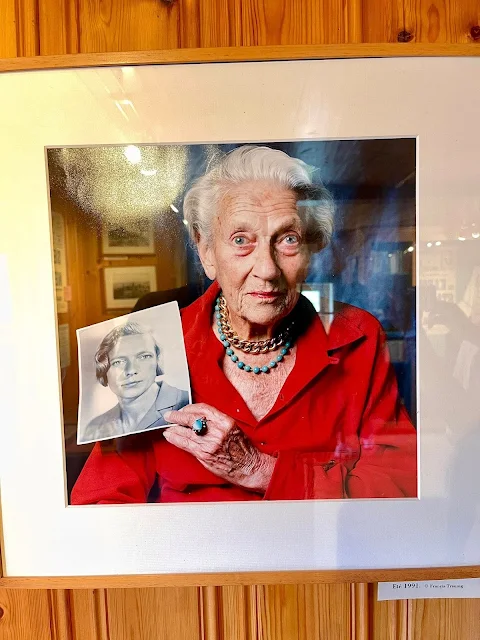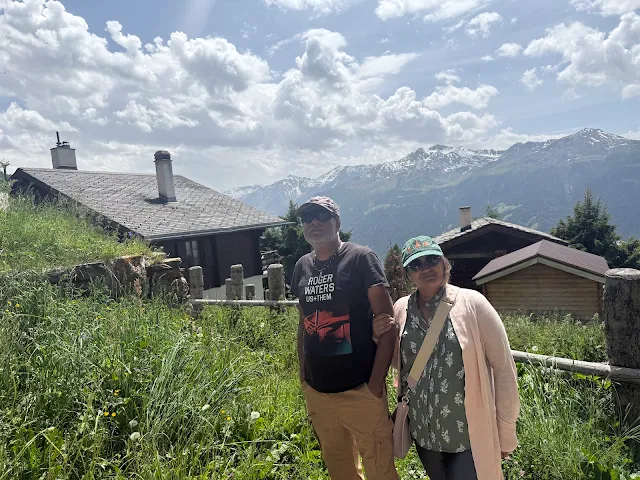From Lyon to Chandolin: Silk & the Silk Road's Ella Maillart Meet Mountain Mischief | France & Switzerland
 |
| Chandolin, Switzerland |
We broke camp at sunrise near Lyon, France, the sky just beginning to blush behind the mountains and the air sharp enough to wake even the sleepiest overlander. Today was the day we (a) visited the famous Silk Museum of Lyon, France and (b) traveled into Switzerland through Charlie Chaplin and Ella Maillart territory. The next chapter of our Silk Road expedition was calling and it came with silk artesans, alpine peaks, endless switchbacks and the promise of standing in the shadow of the Matterhorn and visiting the Chandolin home of legendary Swiss traveler Ella Maillart.
Shehzadi was purring like a mountain lion after a solid night’s rest. Chetak, always the stoic warrior, sat ready and alert, as if daring the Alps to throw their worst at him. The Vagabond Couple and the Odyssean Journey rolled out of camp and pointed the rigs toward the remarkable French metropolis of Lyon.
Lyon
Nestled at the confluence of the Rhône and Saône rivers, Lyon is a city where history whispers from every cobblestone. Founded by the Romans in 43 BC as Lugdunum, it became a pivotal hub of trade and politics in ancient Gaul. Over the centuries, Lyon evolved into a Renaissance masterpiece, its Vieux Lyon (Old Town) a UNESCO-listed labyrinth of traboules (hidden passageways) and ochre-hued buildings.
Lyon's cultural soul is equally rich - home to the Lumière brothers, pioneers of cinema and a gastronomic capital where bouchons (traditional bistros) serve up coq au vin and quenelles. Legends abound, from the shadowy tales of the Traboules used by silk workers to the annual Fête des Lumières, a dazzling festival of lights born from a vow to the Virgin Mary. Lyon is a city where past and present dance in harmony, a living museum of French resilience and creativity.
For over 500 years, Lyon was the silk-weaving capital of Europe, a legacy that began in the 15th century when King Louis XI established the city as a rival to Italian silk producers. By the 18th century, Lyon’s Canuts (silk workers) were crafting fabrics for royalty, while local geniuses like Joseph-Marie Jacquard revolutionized the industry with the Jacquard loom (1804), a precursor to modern computing.
Lyon’s silk workshops also birthed the métier à la tire, a drawloom that enabled breathtakingly intricate designs. This ingenuity extended beyond textiles—the city gave the world the first mechanical calculator (Thomas de Colmar, 1820) and even the humble sewing machine (Barthélemy Thimonnier, 1830).
A Visit to La Maison des Canuts: Where Lyon's Silk Heart Still Beats
| La Maison des Canuts, Lyon, France |
Silk wasn’t just a trade; it was Lyon’s heartbeat, weaving together art, technology and global commerce. Tucked away in Lyon's historic Croix-Rousse district, La Maison des Canuts offers an intimate glimpse into the world of the city's legendary silk weavers. This living museum, housed in an authentic 19th-century silk workshop, brings Lyon's textile heritage to life with clattering Jacquard looms operated by skilled demonstrators who reveal the artistry behind every thread.
The exhibits tell the story of the Canuts - Lyon's proud silk workers - whose technical mastery was matched only by their revolutionary spirit during the 1831 and 1834 uprisings. For the Vagabond Couple and their Toyota pickup Shehzadi, exploring La Maison des Canuts became a profound connection point in their Silk Road journey. Seeing the intricate brocades and velvets produced on these very looms helped them understand how Lyon's textiles once flowed eastward along trade routes, while Asian designs influenced local patterns.
The museum's collection of rare fabrics, including the famous "velours au sabre" (sabre-cut velvet), mirrored textiles they'd encountered in their overland travels from Turkey to China. The highlight came when museum guides demonstrated how silk threads were transformed into luxurious fabrics - a process unchanged for centuries. Standing where generations of artisans worked, the couple gained new appreciation for Lyon's role in the global silk trade.
Switzerland
The Swiss border called us next, the smell of pine still clinging to our clothes and gear. Crossing into Switzerland was smoother than expected. The few guards gave us a quick nod, a wave and then we were in. Properly in. Switzerland hit us like a fairytale wrapped in precision-engineered highways.
We wound through sleepy border towns with wooden chalets and impeccably stacked firewood piles. Cows with enormous bells grazed like they had no idea how famous they were. The air was lighter, the sky bluer and the roads? Immaculate. Even the potholes seemed like they’d written polite apology notes.
Driving through the French-speaking Vaud region, we passed through the lakeside town of Vevey, where Charlie Chaplin spent his final years. There’s something surreal about rolling past lush vineyards and Belle Époque architecture knowing that the Little Tramp himself once wandered these cobblestone streets.
The Chaplin’s World museum sits on the old Manoir de Ban estate and though we didn’t stop this time, it gave us a chuckle to think of his silent antics echoing off the Alps. In a land of dramatic peaks and medieval legends, Chaplin brought a whole other kind of magic—bowler hats, slapstick and a deep love for human connection. Pretty fitting for a pair of traveling couples chasing their own whimsical road story.
 |
| Molignon, Evolène, Switzerland |
Our destination: the picturesque Molignon campsite tucked away in the Val d’Hérens valley, in the Swiss region of Valais. It’s right near the little mountain village of Les Haudères, sitting up around 1,400 meters above sea level, not far from the legendary village of Chandolin, nestled near the base of the Matterhorn. But first, there were valleys to cross and ridges to climb. We took the scenic route—always the scenic route—looping through Sion and winding along alpine roads that felt hand-carved by glacier gods.
 |
| Molignon, Evolène, Switzerland |
Along the way, we passed through tiny hamlets where time seemed to slow down. Villages like Grimentz, with its dark-timbered houses and window boxes overflowing with geraniums. It felt like we’d stepped into a snow globe—minus the snow, for now. These villages have been home to generations of mountain folk—herders, craftspeople and quietly defiant communities that survived avalanches, invasions and centuries of isolation with grit and grace. Their culture is steeped in seasonal rhythms, communal festivals and tales passed down around fires.
The Pyramides d’Euseigne on the way in the Val d’Hérens are a striking geological formation of towering earth pyramids, some reaching up to 15 meters in height, formed over thousands of years through glacial and erosional processes. During the last Ice Age, retreating glaciers left behind moraine deposits, which were later shaped by rainwater and melting snow, carving out the distinctive spires capped by protective boulders.
 |
| Pyramides d’Euseigne |
Historically, these natural monuments have fascinated locals and travelers alike, serving as a testament to the dynamic forces of nature. The Pyramides d’Euseigne are not only a geological wonder but also a cultural landmark, offering insight into the region’s ancient environmental history.
Local legends speak of the "Barbegazi", mythical snow-dwelling creatures with long beards and giant feet who ski the slopes and whistle through storms. Some say they guide lost travelers to safety, others that they mischievously swap trail markers for fun. (Honestly, that would explain a lot of hiking detours.) Then there are the Sennentuntschi tales—stories of mountain shepherds who carved life-sized women from wood and unknowingly summoned spirits to inhabit them. It’s eerie, charming and very Swiss. Moral of the story? Stick to carving cheese.
 |
| Chandolin, Switzerland |
The road up to Chandolin was steep and narrow, full of tight bends and sweeping views that made us want to stop every three minutes for photos. Chetak handled it like a mountain goat on Red Bull. Shehzadi lumbered up steadily, humming her twin-turbo lullaby like a zen tractor in love.
 |
| Chandolin, Switzerland |
Chandolin itself is car-free and the kind of place that makes you question your life choices. Why haven’t we moved here? Why doesn’t every village come with postcard views and a backstory involving explorers?
 |
| Ella Maillart Museum, Chandolin, Switzerland |
Speaking of which, Chandolin was once home to the legendary Ella Maillart. A Swiss traveler, writer, skier and sailor who roamed Central Asia and beyond at a time when women were expected to stay put.
 |
| Portrait of Ella Maillart at her Museum in Chandolin, Switzerland |
In the 1930s, she drove from Geneva to Kabul in a Ford with fellow traveler Peter Fleming (yes, Ian Fleming’s brother). She lived with nomads in the Pamirs, crossed deserts, wrote about it all in vivid detail and somehow made the impossible sound reasonable. Her house still stands here, nestled among the pines, now a quiet monument to fearless curiosity and the original overlander spirit. Basically, Ella did #VanLife before it was a hashtag.
We parked the rigs at our campsite just as the sun began to dip behind the peaks. A golden hush fell over the valley. Mountains turned pink. The sky burned orange, then softened into indigo. We set up camp, brewed mugs of mountain tea and settled in for one of those rare evenings where everything just clicks.
No cell service. No traffic noise. Just the Matterhorn looming in the distance, our trucks resting easy and the stars waiting to come out. Tomorrow, we continue through the Alps, the Silk Road pulling us eastward. But tonight? Tonight belongs to Switzerland.
 |
| Chandolin, Switzerland |
To mountain silence. To Ella’s ghost. To the road ahead. And to never underestimating a Barbegazi with a sense of humor.
Up next: Crossing the Alps by Train: From Switzerland to Italy’s Romantic Shores
After exploring the Swiss Alps, the adventure continues as we board the Autoverlad Brig-Iselle car train, a thrilling shortcut through the Simplon Tunnel that carries Shehzadi (our trusty Toyota Tundra pickup) and Chetak (Odyssean Journey Hilux) straight from Switzerland’s rugged Valais into Italy’s sun-drenched Piedmont. No winding mountain passes—just a smooth 20-minute ride through the heart of the Alps!
Emerging in Iselle, Italy, we descend toward the glittering shores of Lake Como, where pastel villages cling to steep hillsides and villas with manicured gardens whisper of old-world glamour. Then, it’s onward to Venice, Marco Polo’s legendary hometown, where we trade asphalt for canals, parking Shehzadi on the mainland before stepping into a floating masterpiece of bridges, gondolas and Byzantine splendor.
From alpine tunnels to Adriatic dreams, this border crossing isn’t just a route—it’s a time machine.


0 comments